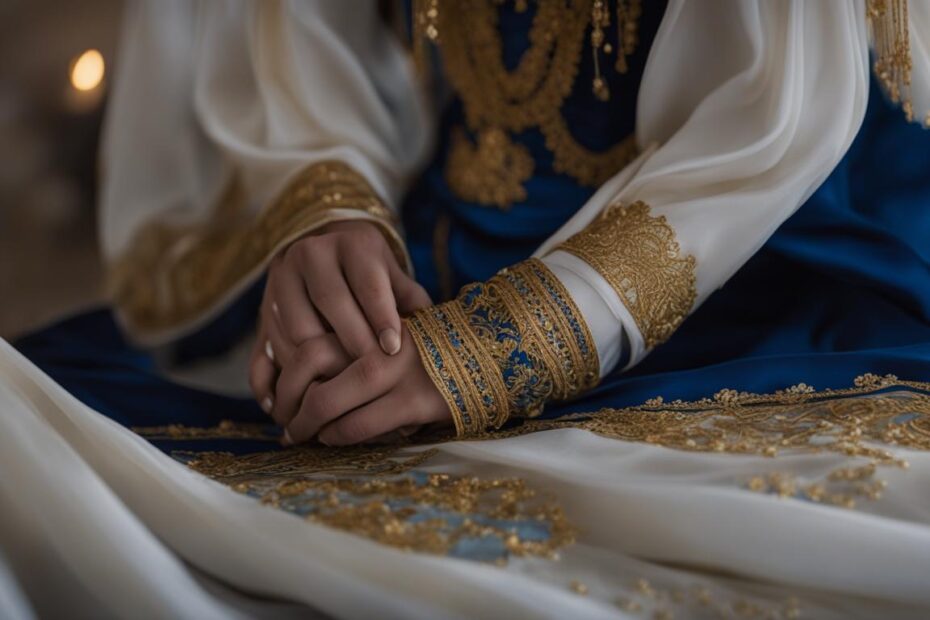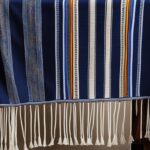The tallit, also known as a prayer shawl, is a significant religious garment in Jewish tradition. It is worn during prayer and certain religious rituals and serves as a reminder of the commandments of the Torah and the wearer’s connection to God. The tallit is also a cornerstone of Jewish faith and tradition, symbolizing one’s devotion and commitment to the Jewish faith.
Key Takeaways:
- The tallit, or prayer shawl, is an important religious garment in Jewish tradition.
- It is worn during prayer and represents the wearer’s connection to God and the commandments of the Torah.
- There may be variations in tallit customs among different Jewish sects.
- Tallitot are traditionally made of wool or silk, but modern variations may incorporate synthetic fibers.
- Over time, prayer shawls have evolved in design, materials, and symbolism.
The Significance of Jewish Prayer Shawls
Jewish prayer shawls, also known as tallitot, hold deep spiritual and symbolic meaning in Jewish tradition. Wearing a tallit during prayer serves as a visual reminder of the divine presence and the commandments. The fringes, known as tzitzit, on the corners of the tallit represent the 613 commandments found in the Torah.
By enveloping themselves in the tallit, individuals enter a sacred space of prayer, reflection, and connection with God. The tallit serves as a physical manifestation of one’s devotion and commitment to the Jewish faith. It acts as a symbolic garment, representing the wearer’s identification as a member of the Jewish community and their adherence to Jewish religious practices.
The symbolism of the tallit extends beyond its physical presence. It serves as a reminder of the individual’s connection to the Jewish people throughout history and their participation in a long-standing tradition. Through the act of wearing the tallit, individuals engage in a spiritual practice that strengthens their relationship with God and deepens their understanding of Jewish values and teachings.
“When I wrap myself in the tallit, I feel a sense of closeness to God and a connection to my ancestors who have worn it before me. It reminds me of the importance of living a life rooted in faith and commitment to the commandments.”
Table: Symbolism of Jewish Prayer Shawls
| Symbol | Meaning |
|---|---|
| Tallit | Physical representation of devotion and commitment to the Jewish faith |
| Tzitzit | Symbolizes the 613 commandments found in the Torah |
| Enveloping in the tallit | Entering a sacred space of prayer, reflection, and connection with God |
| Identification as a member of the Jewish community | Representation of one’s connection to the Jewish people throughout history |
The significance of Jewish prayer shawls, such as the tallit, lies in their ability to create a spiritual connection, serve as a visual reminder of the commandments, and foster a sense of belonging and identity within the Jewish community. Whether woven from wool, silk, or synthetic fibers, the tallit remains a cherished and respected part of Jewish religious practice, carrying with it centuries of tradition and symbolism.
Variations Among Jewish Sects
Within the diverse landscape of Judaism, variations in customs and practices surrounding the use of prayer shawls can be observed among different Jewish sects. While the fundamental concept of the tallit remains universal, there may be differences in the size, design, and specific rituals associated with wearing a prayer shawl.
In Orthodox Judaism, for example, prayer shawls are typically large and may cover the entire body. The tzitzit, or fringes, are usually longer and often hand-tied in a specific manner. Conservative and Reform Jews may have prayer shawls that are slightly smaller in size, and the tzitzit may be machine-made rather than hand-tied. These variations reflect the different approaches to religious observance and interpretation within the Jewish faith.
“The differing customs regarding prayer shawls among Jewish sects are not a source of division, but rather a reflection of the rich diversity within Judaism. Each sect adheres to its own traditions and practices, which contribute to the vibrant tapestry of Jewish life.”
Although there may be variations in prayer shawl customs, it is important to emphasize that these differences do not diminish the significance or sacredness of the prayer shawl itself. Rather, they serve as a testament to the multifaceted nature of the Jewish faith and the ability to adapt religious practices within different cultural and historical contexts.
Table: Variations in Prayer Shawl Customs Among Jewish Sects
| Jewish Sect | Prayer Shawl Size | Tzitzit Style |
|---|---|---|
| Orthodox | Large, may cover entire body | Longer, hand-tied |
| Conservative | Slightly smaller | Machine-made |
| Reform | Slightly smaller | Machine-made |
Materials Used for Prayer Shawls
Prayer shawls, also known as tallitot, can be made from a variety of materials, each with its own significance and qualities. Traditionally, wool and silk have been the preferred choices due to their historical importance in Jewish tradition. Wool represents warmth and comfort, symbolizing the protection and shelter that God provides to His people. Silk, on the other hand, is associated with luxury and beauty, reflecting the reverence and honor given to prayer and religious rituals.
However, in modern times, there has been an emergence of prayer shawls made from synthetic fibers, such as acrylic or polyester. These materials offer increased durability, affordability, and ease of maintenance. They also provide a wider range of colors and designs, allowing individuals to personalize their prayer shawls according to their taste and style.
To decide on the material for a prayer shawl, individuals consider factors such as tradition, personal preference, and practicality. Some may choose to adhere strictly to the use of traditional materials, emphasizing the connection to historical customs and religious significance. Others may opt for synthetic fibers for reasons of convenience or personal comfort. Ultimately, the choice of material does not diminish the spiritual value of the prayer shawl, but rather reflects the diversity and adaptability within the practice of Jewish faith.
Table: Comparison of Materials Used for Prayer Shawls
| Material | Qualities | Symbolism |
|---|---|---|
| Wool | Soft, warm, and breathable | Protection, comfort, and connection to Jewish heritage |
| Silk | Lustrous, lightweight, and delicate | Beauty, reverence, and honor in prayer |
| Synthetic fibers | Durable, affordable, and easy to care for | Variety, personalization, and accessibility |
“The choice of material for a prayer shawl is a personal one, influenced by tradition, comfort, and individual style. Whether made from wool, silk, or synthetic fibers, the prayer shawl remains a powerful symbol of devotion and connection to God.”
“The materials used for prayer shawls represent more than just fabric; they carry symbolism and meaning. Whether it’s the warmth of wool, the elegance of silk, or the versatility of synthetic fibers, the material choice adds another layer of significance to the prayer shawl.”
Evolution of Prayer Shawls Over Time
Prayer shawls have a rich and diverse history that spans centuries. Over time, these sacred garments have undergone changes in design, materials, and symbolic meaning. The evolution of prayer shawls reflects the dynamic nature of Jewish religious practices and cultural influences.
Throughout history, prayer shawls have adapted to the artistic styles and craftsmanship of different periods. Patterns, colors, and motifs have been incorporated into the design of prayer shawls, adding visual appeal and personal expression. These evolving designs have allowed individuals to connect with their faith in a way that resonates with their own cultural background and artistic preferences.
The materials used for prayer shawls have also evolved. While traditional prayer shawls were often made of wool or silk, modern variations may incorporate synthetic fibers for increased durability. These changes in material reflect advancements in textile production and the desire for prayer shawls that are more practical for everyday use.
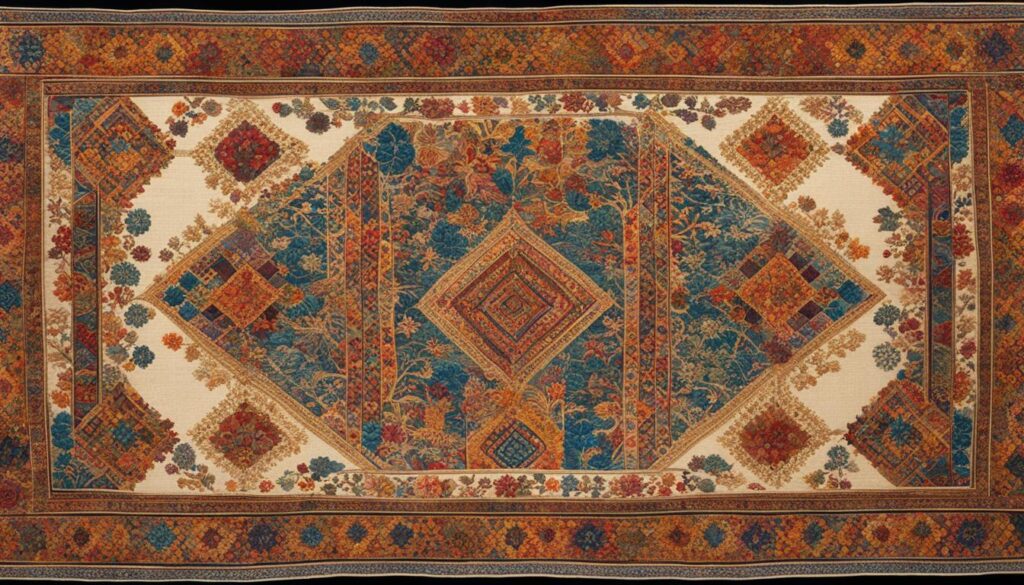
Table: Evolution of Prayer Shawls
| Time Period | Design | Materials | Symbolic Meaning |
|---|---|---|---|
| Ancient Times | Simple woven fabric | Wool or linen | Symbol of devotion and connection to God |
| Middle Ages | Incorporation of decorative patterns | Wool or silk | Representation of Jewish identity and religious observance |
| Modern Era | Exploration of diverse colors and motifs | Wool, silk, or synthetic fibers | Personal expression and connection to Jewish heritage |
The evolution of prayer shawls goes beyond their physical appearance. Symbolically, prayer shawls continue to serve as a tangible reminder of one’s connection to God and the commandments. The act of wearing a prayer shawl during prayer and ritual practices allows individuals to enter a sacred space of spiritual reflection and devotion. While the specific designs and materials may change, the core symbolism and significance of the prayer shawl remain constant.
As prayer shawls have evolved over time, they have remained a cherished aspect of Jewish religious practices. The timeless tradition of wearing a prayer shawl during prayer serves as a powerful symbol of faith, identity, and connection to Jewish heritage.
Lesser-Known Tools in Jewish Rituals
In addition to the tallit, there are other lesser-known tools and ritual objects used in Jewish religious practices. These tools play important roles in enhancing the spiritual connection and observance of Jewish rituals.
Tefillin (Phylacteries)
One such tool is the tefillin, also known as phylacteries. Tefillin consist of two small black boxes containing verses from the Torah, which are attached to leather straps. They are worn by Jewish men during morning prayers as a physical embodiment of one’s commitment to God and the fulfillment of the commandments. Tefillin are a reminder of the importance of studying and observing the Torah, and they symbolize the unity of heart, mind, and action in service to God.
Kippah (Yarmulke)
Another commonly used ritual object is the kippah, also known as a yarmulke. The kippah is a small, round head covering traditionally worn by Jewish men in synagogue and during religious ceremonies. It is a symbol of respect and reverence for God, reminding individuals of the presence of the divine above them. Wearing a kippah also represents humility and the recognition that God is supreme. In some communities, women also choose to wear a kippah as a sign of religious devotion.
Shofar
The shofar, a ram’s horn, is a unique ritual object used during Jewish holidays and special occasions. It is blown to produce a distinct sound that carries deep spiritual significance. The shofar’s sound serves as a call to awaken the soul, evoke repentance, and connect with the divine. It is most commonly associated with the Jewish New Year, Rosh Hashanah, where its powerful blasts mark the beginning of the High Holy Days.
Havdalah Set
The havdalah set, consisting of a cup, candle, and spice box, is used to mark the end of the Jewish Sabbath and the beginning of the new week. Havdalah, which means “separation” in Hebrew, is a special ceremony that involves blessings over wine, spices, and the light of a braided candle. The havdalah set represents the transition from the sacredness of the Sabbath back to the everyday activities of the week. It signifies the separation between the holy and the mundane, reminding individuals to carry the light of the Sabbath throughout the week ahead.
| Tool | Symbolism |
|---|---|
| Tefillin (Phylacteries) | Commitment to God and fulfillment of commandments |
| Kippah (Yarmulke) | Respect, reverence, humility, and recognition of God’s presence |
| Shofar | Awakening the soul, repentance, and connecting with the divine |
| Havdalah Set | Transition from the sacredness of the Sabbath to the new week |
Messianic Prayer Shawls
Messianic prayer shawls, also known as Messianic tallitot, are prayer garments used by individuals who identify as Messianic Jews or Hebrew Christians. These prayer shawls incorporate elements that symbolize the person’s faith in Jesus as the Messiah. Messianic prayer shawls are a way for individuals within this movement to express their dual identity, embracing both Jewish heritage and belief in Jesus as the Messiah.
In practice, Messianic prayer shawls are worn during prayer and worship just like traditional Jewish prayer shawls. They serve as a visual reminder of the wearer’s faith in Jesus as the Messiah and their connection to both Jewish and Christian traditions. The symbolism present in Messianic prayer shawls allows individuals to express their religious beliefs and personal journey in a tangible and meaningful way.
It is important to note that Messianic prayer shawls are unique to the Messianic Jewish movement and are not used in traditional Jewish religious practices. The dual identity expressed through the use of these prayer shawls is specific to individuals who identify as both Jewish and Christian, and it is not a part of mainstream Jewish tradition.
Messianic Jewish Practice and the Importance of Prayer Shawls
Prayer shawls hold a significant place within Messianic Jewish practice, serving as an essential tool for spiritual connection and expression of faith. These prayer shawls, also known as Messianic tallitot, represent a dual identity embraced by individuals who identify as Messianic Jews or Hebrew Christians. The use of prayer shawls in Messianic Jewish worship creates a sacred space for deepening one’s spiritual connection and enhancing the overall religious experience.
The prayer shawls used in Messianic Jewish practice hold deep religious and symbolic significance. Like traditional Jewish prayer shawls, the Messianic tallitot serve as a visual reminder of devotion and commitment to faith, but they also incorporate elements that symbolize belief in Jesus as the Messiah. By wearing these prayer shawls during prayer and worship, individuals express their dual identity, honoring both their Jewish heritage and their faith in Jesus as the Savior.
Through the use of prayer shawls, Messianic Jews find a tangible means of connecting with God and expressing their spiritual devotion. These prayer garments help create an atmosphere of reverence and facilitate a deeper sense of presence during prayer and worship. The Messianic tallitot serve as a powerful symbol of their faith and provide a visual representation of their commitment to both Jewish tradition and belief in Jesus as the Messiah.
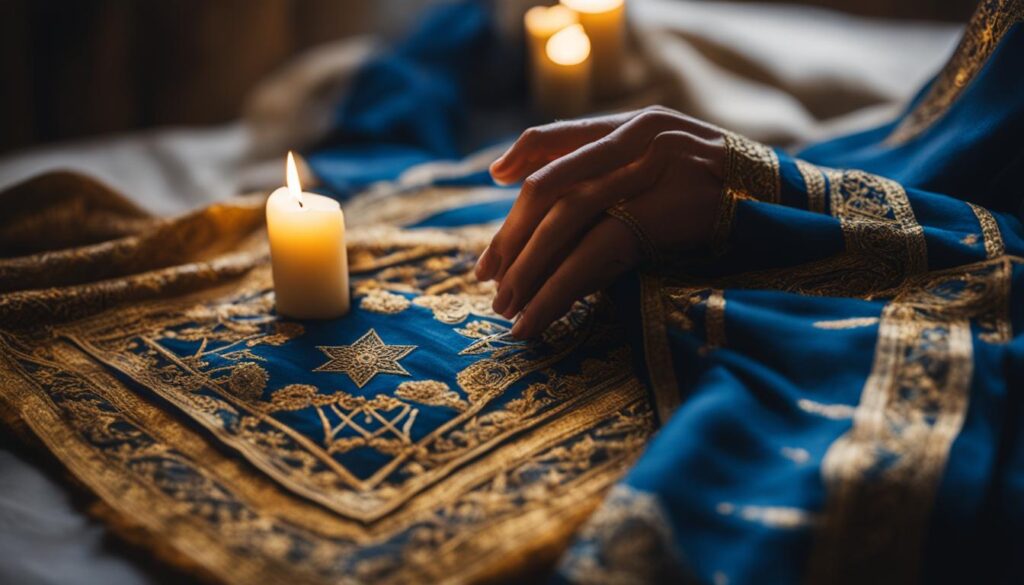
The Symbolism of Messianic Prayer Shawls
The symbolism embedded in Messianic prayer shawls is multi-layered and profound. They represent a bridge between two worlds, honoring both Jewish tradition and Messianic beliefs. The use of traditional Jewish prayer shawls acknowledges the deep roots of faith and heritage within the Jewish community, while incorporating Messianic symbols reflects the unique perspective and spiritual journey of Messianic Jews.
The Messianic tallitot often feature elements such as the Star of David, the Menorah, or the Hebrew name for Jesus (Yeshua). These symbols serve to reinforce the individual’s belief in Jesus as the fulfillment of Jewish prophecy, the promised Messiah. By wearing these prayer shawls, Messianic Jews express their allegiance to both the Jewish faith and their commitment to following Jesus.
Overall, the use of prayer shawls in Messianic Jewish practice exemplifies the deep spiritual connection and devotion that individuals have to their faith. These prayer garments serve as a visible and tangible expression of their beliefs and create a sacred space for worship, reflection, and connection with God.
Where to Find Quality Prayer Shawls
Quality prayer shawls can be found both online and at local Judaica stores. Online retailers specializing in Jewish religious items offer a wide range of options and the convenience of browsing and purchasing from the comfort of your own home. Some popular online retailers for prayer shawls include Judaica.com, TheTallisLady.com, and World of Judaica.
If you prefer a more personalized experience, local Judaica stores and synagogue gift shops are great resources. These establishments often have knowledgeable staff who can assist you in finding the perfect prayer shawl and provide guidance on appropriate blessings and rituals associated with the tallit.
When shopping for a quality prayer shawl, it’s important to consider factors such as the material, design, and craftsmanship. Traditional prayer shawls are often made of wool or silk, but there are also synthetic options available for increased durability and ease of care. Take the time to research different styles and designs to find one that resonates with your personal taste and spiritual connection.
| Online Retailers | Local Judaica Stores |
|---|---|
| Judaica.com | Local synagogue gift shops |
| TheTallisLady.com | Specialty Judaica stores |
| World of Judaica | Community Judaica stores |
Whether you choose to shop online or visit a local store, finding a quality prayer shawl is an important investment in your spiritual practice. Take the time to explore different options and choose a prayer shawl that not only meets your aesthetic preferences but also enhances your connection to Jewish tradition and prayer.
How to Care for Your Prayer Shawl
Proper care is essential to ensure the longevity and beauty of your prayer shawl. By following these cleaning and maintenance tips, you can keep your tallit in excellent condition:
- Hand washing: It is recommended to hand wash your prayer shawl in cold water using a gentle detergent. Avoid using bleach or harsh chemicals that could damage the fabric.
- Gentle handling: When washing, avoid twisting or wringing the fabric to prevent stretching or tearing. Instead, gently squeeze out the excess water without applying too much pressure.
- Air drying: After washing, air dry your tallit in a shaded area, away from direct sunlight. This will prevent the colors from fading and the fabric from becoming damaged.
- Storage: When not in use, store your prayer shawl in a clean and dry place. It is advisable to fold it carefully and wrap it in a soft cloth or tissue paper to protect it from dust and moisture.
“Proper care and maintenance of your prayer shawl not only preserves its physical condition but also honors its spiritual significance.”
The Importance of Regular Maintenance
Your prayer shawl is more than just a garment; it is a sacred symbol of your faith. Regular cleaning and maintenance not only ensure its physical durability but also help to maintain its spiritual connection. By caring for your prayer shawl, you are expressing reverence for the religious traditions it represents.
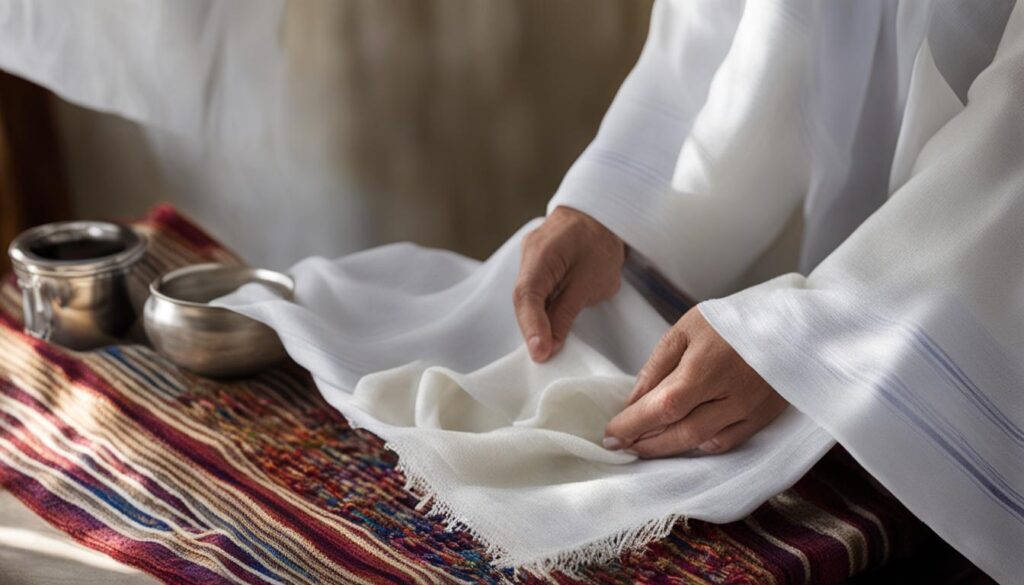
Embracing the Significance of Prayer Shawls
Jewish prayer shawls, also known as tallitot, hold a deep spiritual significance within Jewish tradition. Wearing a tallit during prayer allows individuals to establish a profound connection with the divine and reaffirm their commitment to the commandments of the Torah. This sacred garment serves as a visual reminder of one’s devotion to the Jewish faith and the spiritual connection that prayer brings.
Prayer shawls are an integral part of Jewish tradition, symbolizing the centuries-old heritage and spiritual practices of the Jewish people. When enveloped in the tallit, individuals enter a sacred space of prayer and reflection, seeking solace and guidance from God. The act of wearing a prayer shawl is not only a religious practice but also a deeply personal expression of faith and devotion.
Throughout different Jewish sects, variations may exist in the customs surrounding the use of prayer shawls. These variations, however, do not diminish the overall significance of the prayer shawl but instead reflect the diversity within the Jewish faith. The choice of materials for prayer shawls may also differ, with traditional options ranging from wool to silk. Nowadays, synthetic fibers are also used to increase durability, allowing individuals to find a prayer shawl that aligns with their preferences and needs.
The significance of prayer shawls has evolved over time, adapting to changing cultural and artistic influences. From the incorporation of different patterns and motifs to the use of colors, prayer shawls have embraced modern aesthetics while maintaining their core symbolism. This evolution allows individuals to find a prayer shawl that resonates with their personal journey and enhances their spiritual connection through prayer and reflection.
Conclusion
Jewish prayer shawls, such as the tallit, hold deep spiritual and symbolic significance within the Jewish faith. They serve as a visual reminder of the divine presence and the commandments of the Torah. Wearing a prayer shawl during prayer and religious rituals creates a sacred space for connection, reflection, and devotion to God.
Prayer shawls are more than just religious garments; they are a personal expression of faith and a way to connect with one’s Jewish heritage. Whether traditional or modern in design, prayer shawls provide individuals with a unique opportunity to participate in shared traditions and embrace the spiritual significance of their Jewish identity.
Throughout history, prayer shawls have evolved in terms of design, materials, and symbolism, reflecting the cultural and artistic influences on Jewish religious practices. The use of different materials like wool, silk, and synthetic fibers allows for personal preference and comfort. Additionally, variations in customs and practices among different Jewish sects highlight the diverse nature of the Jewish faith.
Overall, prayer shawls play a vital role in Jewish religious practices, acting as a tangible connection to centuries of tradition and spirituality. They enable individuals to deepen their spiritual connection, express their faith, and engage in prayer and reflection. The significance of the Jewish prayer shawl goes beyond its physical form, representing a powerful symbol of personal and communal devotion.
FAQ
What is the significance of wearing a tallit during prayer?
Wearing a tallit serves as a visual reminder of the divine presence and the commandments.
What do the fringes on the corners of the tallit represent?
The fringes, known as tzitzit, represent the 613 commandments found in the Torah.
Are there variations in prayer shawl customs among different Jewish sects?
Yes, different sects may have variations in their customs and practices surrounding the use of prayer shawls.
What materials are prayer shawls typically made of?
Traditional prayer shawls are often made of wool or silk, while modern variations may incorporate synthetic fibers.
How have prayer shawls evolved over time?
Prayer shawls have evolved in terms of design, materials, and symbolism, reflecting changing cultural influences.
What are some other ritual objects used in Jewish religious practices?
Tefillin (phylacteries) and the kippah (yarmulke) are other tools used in Jewish religious practices.
What are Messianic prayer shawls?
Messianic prayer shawls are prayer garments used by individuals who identify as Messianic Jews or Hebrew Christians.
How do prayer shawls enhance Messianic Jewish practice?
Prayer shawls deepen the individual’s spiritual connection and enhance their overall religious experience.
Where can I find quality prayer shawls?
Quality prayer shawls can be found online at retailers specializing in Jewish religious items or at local Judaica stores and synagogue gift shops.
How should I care for my prayer shawl?
Specific care instructions may vary, but generally, hand washing in cold water with a gentle detergent and air drying in a shaded area is recommended.
What is the significance of prayer shawls in Jewish faith and tradition?
Prayer shawls provide individuals with a tangible expression of their faith and a way to connect with their heritage and participate in shared traditions.
Source Links
- https://holylandmarket.com/blogs/news/everything-you-need-to-know-about-messianic-prayer-shawl-tallits
- https://www.christianbook.com/tallit-experience-mysteries-prayer-hidden-treasures/charlie-kluge/9781629987330/pd/987330
- https://medium.com/@gloriousproductonline/jewish-prayer-shawls-in-san-antonio-embracing-tradition-and-spirituality-9877bd5b152e


